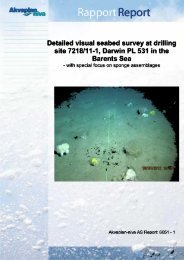A study of the priority substances of the Water Framework Directive ...
A study of the priority substances of the Water Framework Directive ...
A study of the priority substances of the Water Framework Directive ...
Create successful ePaper yourself
Turn your PDF publications into a flip-book with our unique Google optimized e-Paper software.
..:::::::::: polyaromatic hydrocarbons (PAH)<br />
..:::68<br />
Marine biota<br />
17 harbours or fjords have restrictions on consumption<br />
and sales <strong>of</strong> seafood because <strong>of</strong> high<br />
levels <strong>of</strong> PAH.<br />
Fresh water sediment<br />
Many lakes are strongly polluted by PAH, especially<br />
along <strong>the</strong> coast from Grenland to Sogn og<br />
Fjordane. Local air pollution (10 km or less to<br />
polluter) is a major source.<br />
Fresh water biota<br />
PAH levels in fresh water biota (fish) are found<br />
to be low.<br />
Need for fur<strong>the</strong>r screening and monitoring<br />
PAH is thoroughly screened, and <strong>the</strong>re is probably<br />
no fur<strong>the</strong>r need for screening, although<br />
groundwater levels could be fur<strong>the</strong>r studied.<br />
PAH levels in Norwegian environment are high,<br />
and monitoring should continue in order to estimate<br />
health risks and effectiveness <strong>of</strong> policies<br />
and measures. There is a chance that <strong>the</strong>re<br />
might be more hotspots that are currently not<br />
mapped / known.<br />
Analysis<br />
PAH-analysis is well developed. PAH analysis<br />
are normally performed as a multi-compound<br />
method including from 7, 16, up to over 40 different<br />
PAH-compounds including anthracene,<br />
benzo(a)pyrene, benzo(b)fluoran<strong>the</strong>ne,<br />
benzo(k)fluoran<strong>the</strong>ne, benzo(g,h,i)perylene, fluoran<strong>the</strong>ne,<br />
indeno(1,2,3-cd)pyrene, and naphthalene.<br />
Methods<br />
The methods are based on extraction with an<br />
organic solvent and chromatographic or liquidliquid<br />
extraction (Grimmer method) clean-up.<br />
Separation and quantification is normally performed<br />
with ei<strong>the</strong>r GC- or LC-based methods:<br />
normally GC/FID or GC/MS or HPLC/FLD.<br />
Quantification for <strong>the</strong> most advanced methods<br />
is based on <strong>the</strong> use <strong>of</strong> isotope labelled internal<br />
standards. Naphthalene is <strong>the</strong> most volatile<br />
PAH compound and can also be analysed with<br />
purge-and-trap methods described for <strong>the</strong><br />
volatile organic compounds (VOC) (se under<br />
benzene or dichloromethane).<br />
Synergy with o<strong>the</strong>r analyses<br />
Sample extraction can be co-ordinated with <strong>the</strong><br />
analysis <strong>of</strong> o<strong>the</strong>r organic semivolatile pollutants<br />
A <strong>study</strong> <strong>of</strong> <strong>the</strong> <strong>priority</strong> <strong>substances</strong> <strong>of</strong> <strong>the</strong> <strong>Water</strong> <strong>Framework</strong> <strong>Directive</strong><br />
TA-2140/2005<br />
as PBDE, HCH, and SCCP/MCCP. However,<br />
<strong>the</strong> clean-up and analysis <strong>of</strong> PAH is different<br />
from <strong>the</strong> o<strong>the</strong>r compounds and is normally performed<br />
as a separate method.<br />
References<br />
� CIRCA, Royal Haskoning: Fact sheets on<br />
production, use and release <strong>of</strong> <strong>priority</strong> <strong>substances</strong><br />
in <strong>the</strong> WFD, PAH, Final version 31<br />
January 2001.<br />
� HSDB: PAH.<br />
� ClassLab: PAH.<br />
� SFT PAH 1995-2002.<br />
� Heavy metals and persistent organic pollutants<br />
in sediments and fish from lakes in<br />
Nor<strong>the</strong>rn and Arctic regions <strong>of</strong> Norway, rapportnr.<br />
688/97.<br />
� Fylkesvise tiltaksplaner for forurensede sedimenter,<br />
Rapport fra fase 1 for Farsundsområdet<br />
med Lyngdalsfjorden, Vest-Agder.<br />
� Miljøgifter i fisk, skalldyr og sediment i havneområder<br />
og fjorder i Rogaland 1999-2000.<br />
TA-1843/2001.<br />
� Miljøgifter i havneområder i Nordland, rapport<br />
876/03.<br />
� Miljøgifter i marine sediment og organismer i<br />
havneområdene ved Harstad, Tromsø,<br />
Hammerfest og Honningsvåg 1997-98, TA-<br />
1697/2000.<br />
� Miljøgifter og radioaktivitet i norsk fauna -<br />
inkludert Arktis og Antarktis, utredning for DN<br />
nr. 1999-5.<br />
� Miljøgiftundersøkelse i havner i Telemark,<br />
Vestfold, Akershus og Østfold 1999. TA-1885-<br />
2002.<br />
� Miljøgiftundersøkelse i havner på Agder<br />
1997-1998. PAH, PCB, tungmetaller i TBT i<br />
sedimenter og organismer. Rapport 799/00, TA-<br />
1728/2000.<br />
� Miljøovervåkning i Sandefjordsfjorden og<br />
indre Mefjorden, 1997-1998. Delrapport 2.<br />
Miljøgifter i sedimenter. TA-1585/1998.<br />
� National Comments regarding <strong>the</strong> Norwegian<br />
data for 2003. Joint Assessment and Monitoring<br />
Programme (JAMP), rapport 921/2004.<br />
� Overvåking av miljøgifter i marine sedimenter<br />
og organismer, 1981-1999. Joint Assessment<br />
and Monitoring Programme (JAMP), TA-1797-<br />
2001.<br />
� Regional undersøkelse av miljøgifter i<br />
innsjøsedimenter. Delrapport 1. Organiske<br />
mikr<strong>of</strong>orurensninger. Rapportnr. 712/97.<br />
� Sonderende undersøkelser i norske havner og

















